Article
Top ACA News: Medicaid Expansion, Plan Satisfaction, and More
Author(s):
Republican presidential hopefuls may all be ready to repeal and replace the Affordable Care Act, but new reports in August found the health law continues to make big changes to the US healthcare system.
Republican presidential hopefuls may all be ready to repeal and replace the Affordable Care Act (ACA) should they win the 2016 presidential election, but in the meantime the health law continues to make big changes to the US healthcare system.
During the month of August, a number of news items came out pertaining to the ACA and its impact on healthcare in the US. From consumer satisfaction with exchange plans and decision support tools to Medicaid expansion plans and the overall uninsured rate, people are closely watching the impact of the ACA.
10. Special Enrollment Period
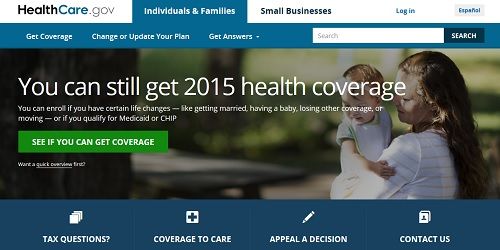
HealthCare.gov screenshot
From February 23 to June 30, nearly 1 million new consumers selected a health plan through HealthCare.gov because they qualified for a special enrollment period (SEP), according to CMS.
Half of these selections were because of the loss of health coverage, while 19% were because consumers had become ineligible for Medicaid. Consumers qualify for a SEP due to exceptional circumstances, such as loss of coverage, loss of Medicaid eligibility, or change in family status (such as marriage or the birth of a child). Florida had the most SEP plan selections.
Enrollment during the SEP was below what people expected, but there was a spike around tax season while people signed up to avoid the mandate penalty. This year, the government had included a SEP for tax season to give people who paid the fee this year for not being covered in 2014 one last chance to get coverage for 2015 and avoid paying a fee next year.
9. ACA Consumers Relatively Happy
Consumers who purchased insurance under the ACA were not just happy with their insurance, but they were actually more satisfied than people with employer-sponsored coverage, according to a survey from J.D. Power and Associates.
The survey examined 6 attributes: claims processing, communications, cost, coverage and benefits, customer service, and provider selection.
Satisfaction with the ACA’s insurance exchange enrollment process significantly increased from 2014 for new enrollees, but members who re-enrolled still had a higher satisfaction score than new enrollees. In addition, members who auto re-enrolled were more satisfied with the process than those who did not.
Overall, marketplace plan satisfaction had a score of 696 on a 1000-point scale compared with a score of 679 for individuals on traditional, mostly employer-based, plans not purchased on an exchange.
8. Arkansas Seeks Changes to Medicaid Expansion Waiver
The state of Arkansas represents the first state to expand Medicaid through the use of an approved waiver. With the waiver, the state was able to create a “private option” through which Medicaid funds were used as premium assistance to purchase coverage for newly eligible adults.
Arkansas reported the nation’s largest drop in the rate of uninsured Americans under the ACA. When Governor Asa Hutchinson was elected in November 2014, he left the waiver from CMS intact. Now, he is looking to require that at least some beneficiaries be enrolled in workforce training in addition to other changes he will forward to the legislature.
7. Exchange Enrollees Are Cost Savvy, Informed
In a slight contradiction to the findings of the J.D. Power survey, the 2015 Survey of US Health Care Consumers from Deloitte Center for Health Solutions found that enrollees who purchased plans on the public health insurance exchanges are less likely to be satisfied with their current health plan compared with individuals in employer plans or Medicare.
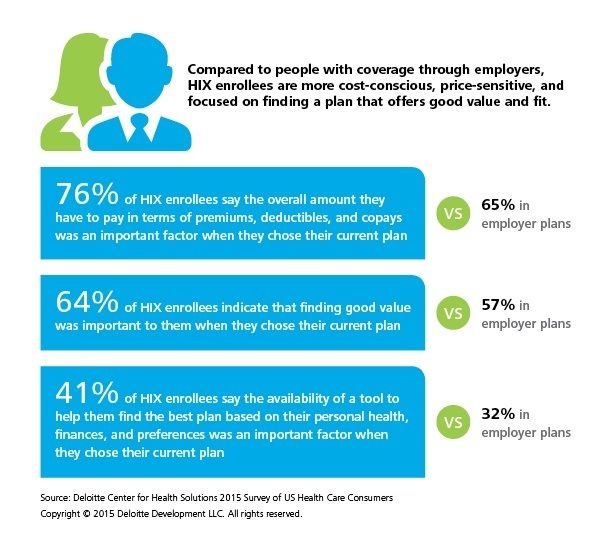
The most common driver of plan dissatisfaction, and ultimately plan switching, was price. Only one-fourth of respondents said they believe they can get affordable care when they need it. Enrollees who purchased plans on the exchanges are paying greater attention to healthcare costs and healthcare quality, according to Deloitte.
6. Tax Issues Jeopardize ACA Financial Help
Approximately 40% of all households that received tax credits for health insurance under the ACA are at risk of losing their financial help for next year. Consumers receiving healthcare tax credits must file tax returns that account for the money from the government. However, some of these households typically don’t file taxes because their incomes are low enough they don’t need to.
The 1.8 million households at risk fall into 3 groups: those who received tax credits and requested an extension to file their returns and have yet to file; those who simply have not filed a 2014 tax return yet; and those who omitted a new form accounting for this financial assistance when they filed their tax returns.
5. HealthCare.gov Controls May Not Be Working
The ACA may have caused large reductions in the percentage of uninsured individuals across the nation, but some people getting insurance under the health law may not actually be eligible.
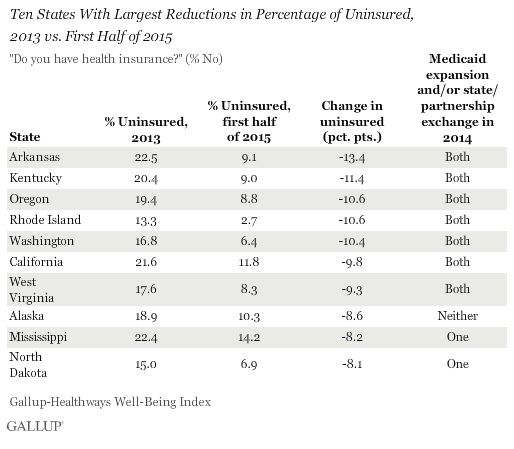
The Office of the Inspector General (OIG) found that HealthCare.gov’s internal controls were not completely effective at weeding out consumers who are not eligible for health coverage on the exchange or not eligible for subsidies during the first open enrollment period. Earlier, the Government Accountability Office reported that 11 phony applications successfully got through the system, received coverage for non-existent individuals, and were subsequently re-enrolled for 2015.
After conducting sample reviews and performing other audit procedures, OIG found deficiencies related to verifying applicants’ eligibility, such as that annual household income was not always verified properly, and that inconsistencies related to certain eligibility requirements were not always resolved properly.
4. Help Needed to Make Informed Health Plan Decisions
Based on the data available to consumers before and after creating an account to shop for health plans on HealthCare.gov and 12 state-based exchanges, researchers determined that these sites need to take more steps to support consumers looking to make informed health plan decisions.
Although the exchanges did show improvements from the first open enrollment to the second, tools that would help consumers choose plans are still not universally available.
Only 4 states included health plan quality rankings, 3 states included out-of-pocket estimators, and most states used the premium amount as the default plan order, which may cause consumers to not pay enough attention to other potential out-of-pocket expenses.
3. Millions Are Missing Out on Their Subsidies
More trouble with ACA financial assistance.
Although enrollees on the ACA’s health insurance exchanges may be eligible for both subsidies and tax credits, 2 million individuals who are eligible for subsidies are not receiving this federal assistance, according to an analysis from Avalere Health.
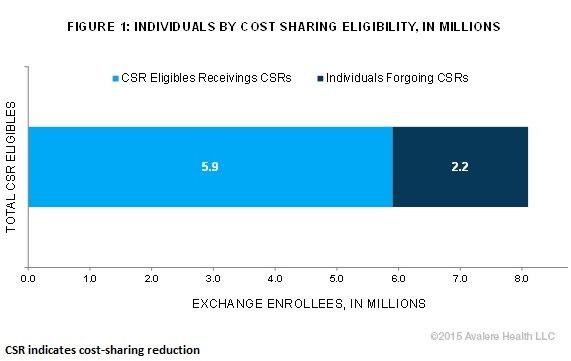
In order to receive subsidies, eligible consumers have to choose a plan on the silver level; unfortunately, those who enroll in bronze plans, which have lower premiums, will not receive subsidies for which they are eligible.
By not appropriately choosing a qualified health plan, these consumers are payment more out-of-pocket costs than they should.
2. ACA Underfunded by $500 Billion
Over the next decade an additional investment of roughly $454 billion to $559 billion will be necessary to ensure the long-term success of the ACA, according to findings from the Urban Institute. Despite the needed money, the health law will still be responsible for reducing health expenditures by $2.5 trillion between 2014 and 2019.
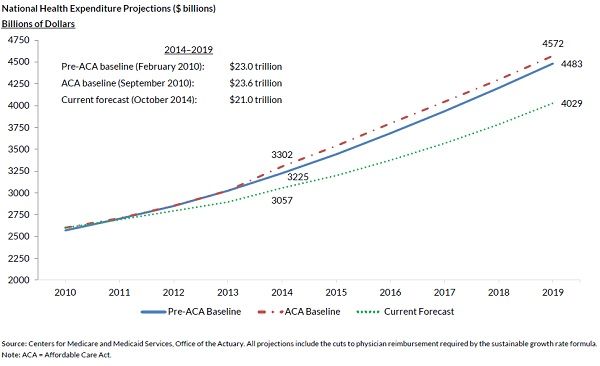
The authors also predict that high-cost premiums for low-income families and high-priced premiums for plans requiring considerable amounts of cost sharing will likely result in a decrease in enrollment numbers in the future.
1. America’s Uninsured Rate Falls to Under 10%
For the first time in half a century, the uninsured rate in America has fallen below 10%, according a report from the CDC. The results from this survey were based on January through March 2015 and compared to the same time a year ago, the uninsured rate was still at 13.1%.
The ACA was clearly a huge factor in the drop in the rate of uninsured Americans. From 2013 to early 2015, nearly 16 million fewer American were uninsured. There were increases in coverage among adults with private coverage (67.3% to 70.4%), among children under the age of 18 with private coverage (52.6% to 56.3%), and among those under the age of 65 years with private coverage through the health insurance marketplaces (2.5% to 3.6%).




